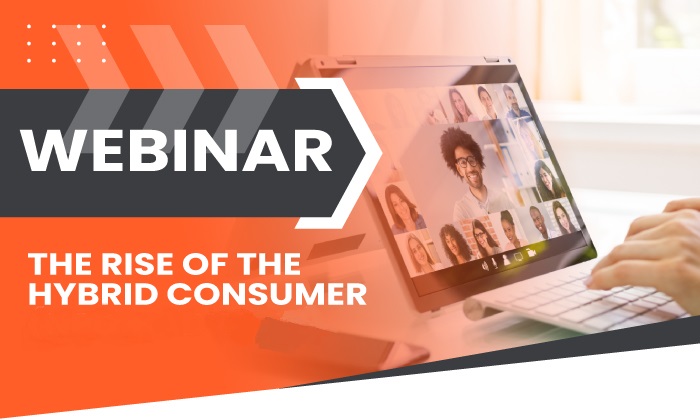
I hope you enjoy reading this blog post.
If you want my team to just do your marketing for you, click here.

As people return to physical shopping post-pandemic, a new behavior has emerged: hybrid shopping. Put simply, hybrid shopping is a blend of physical and digital shopping.
Given this trend, it’s important to create strategies that provide consumers with seamless, personalized, and convenient shopping experiences across digital and brick-and-mortar shops. Brands must reevaluate how they advertise, provide support, and even how they go about suggesting products.
Wondering how to get started? Learn how to better connect with hybrid consumers in the upcoming webinar we are presenting with Adweek on The Rise of the Hybrid Consumer and How They are Changing the Way We Shop on Thursday, May 5th at 1pm EST
The Rise of the Hybrid Consumer: How They Came to Be
In the post-Covid world, consumers have been rethinking, reevaluating, and adapting their lifestyles accordingly. As a result, their interests, shopping behaviors, and preferences have changed significantly.
While the “Hybrid Consumer” may seem like a new concept, we have been building towards them for a few years now. It was just digitally accelerated due to the pandemic.
In 2020, consumers did most of their shopping online; in fact, online sales grew by a whopping 31.8 percent from 2019 to 2020. This was more than double their average annual growth rate which was already impressive enough.

When businesses started reopening in 2021 and consumers began returning to in-store physical shopping, they didn’t abandon their online behaviors.
As “Hybrid Consumers”, they no longer distinguish between online and offline channels. For example, they may look at an item in-store but then do more research online before making a purchase there. They may also research and buy online before picking up a product in-store.
Rather, they’ve become “hybrid consumers” and no longer distinguish between online and offline channels. For example, hybrid consumers may look at items in-store, but complete their purchase online. The inverse is also true: they may shop online and pick up in-store.
As a result of these shifts, shoppers are creating new opportunities and challenges for marketers. It is more important than ever for businesses to track consumer actions to come up with a plan that better reaches and engages them.
Learn more about how to capitalize on these opportunities in the upcoming webinar on Thursday, May 5th.
Why Hybrid Consumers Are Important
“Hybrid Shopping” has caused a surge in sales for online marketplaces like Amazon, Walmart, Best Buy, Etsy, and Home Depot.
In fact, e-commerce sales are still growing and are expected to hit $7.391 trillion by 2025. E-commerce accounted for about $1 in $5 of total retail sales in 2020 and 2021 and as systems improve to benefit hybrid consumers, this could continue increasing.
Since consumers are now making purchase decisions based on a combination of in-store and online interactions, businesses much cater to the cultural shift which this webinar will prepare you for.
What the Rise of Hybrid Consumers Means to Brands
Hybrid consumers no longer distinguish between online and offline channels. They might go into a Walmart or Best Buy and see something they like, but then make their purchase through a third-party marketplace seller online.
If you aren’t creating more personalized and seamless shopping experiences that hybrid consumers want, they will look elsewhere to make their purchases.
What we are seeing is just the beginning of hybrid shopping and as consumer expectations evolve, so will the experiences needed to reach them. As people get accustomed to the seamless integration of physical and digital experiences, the “hybrid consumer” will continue to change. Things like personalization and ease-of-use were a marketing strategy at best, and an afterthought at worst.
Consumers now expect shopping to be quick, convenient, and to catered to their satisfaction. Businesses must adapt, improve their online processes, and consider what experiences are needed to match the expectations of their target audience.
Who Will Benefit from This Webinar?
Some important stakeholders who will benefit from the content taught in this webinar include:
- e-commerce business owners looking to grow their revenue
- businesses looking to improve their online capabilities
- marketers who have clients with revenue-growth goals
- small business owners looking to improve online and in-store experiences
- designers and developers looking to create seamless online experiences for consumers
What Businesses Will Benefit from This Webinar?
Any business will benefit from the content taught in this webinar, especially those with an online and physical presence.
E-commerce businesses will learn actionable strategies that will drive more conversions and, thereby, grow their revenue. Shops that previously focused on physical sales will learn how to create digital experiences that will drive more traffic, increase their revenue, and grow their customer base.
What You’ll Learn in This Webinar
There will be lots of valuable content included in this webinar to help businesses adapt for the hybrid consumer of today and the changes to come tomorrow. A few key things include:
- How your brand can maintain the right mix of online and offline strategies to maximize customer acquisition and retention.
- Key opportunities for marketers to respond to new consumer expectations.
- Strategies for building a more integrated marketing model.
To learn more about these specific strategies, join us on Thursday, May 5, at 1pm EST.

See How My Agency Can Drive Massive Amounts of Traffic to Your Website
- SEO – unlock massive amounts of SEO traffic. See real results.
- Content Marketing – our team creates epic content that will get shared, get links, and attract traffic.
- Paid Media – effective paid strategies with clear ROI.